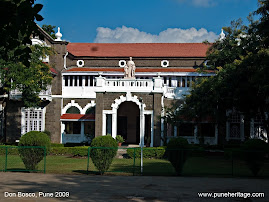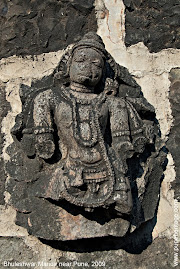Wondering about the title? Well, I am wondering why someone would paint a stone structure. Stones do not need paint, Concrete does. And this self-professed Shilpakar (why does he call himself a sculptor? Restoration and painting do not qualify as sculpting) who has very proudly painted his name on a national Heritage site needs to be made aware of some civic norms.
I consider this to be a form of vandalisation, or even destruction. Robbing something of its original form and beauty is not restoration!
Now that I have got the thorn out of my throat I can actually talk about this 14th century Shiva temple– called Changavteshwar Devasthan, situated in Saswad (about 30 km from Pune by road). Perched in one corner of a Devrai-a small but dense, sacred grove (now not that dense), the small bridge crossing over a spring water channel makes a beautiful picture.
Rather overbearing steps welcome one, almost to drive home the point that one is entering the abode of someone higher up! This temple is actually built like a fortress, with a Dindi Darvaja (main entrance), a Chor Darvaja (secret entry door), and a Tat (a fortress wall). There are two Deepmalas (pillars with multiple spouts) to hold Divas (oil lamps) - one on each side of the temple. These appear to depict the an arm with a palm - signifying many people holding oil lamps for God.
A small replica of Nandi (the bull) and Lord Shiva’s vahan (carrier) sits guard outside the temple. The large Nandi carved from stone is eye catching. Similar Nandis are found in all the temples at Saswad and also at Bhuleshwar temple (featured elsewhere on this blog/ site).
The use of animal figures like a ram, bear, wild boar, buffalo and even (most intriguingly) a Sphinx indicate that there might have been a considerable influence of Egyptian architecture.
The Amalak (top of the main dome) and the minarets together make a very interesting Kalas (dome). Temples built around this time have statuettes of Indian saints (Dynaneshwar, Tukaram, Tulsidas, Gautam Buddha and Mahavir). Tulsi Baug Mandir in Pune follows the same pattern for the dome. This probably signifies how highly regarded the saints were. A panoramic view of this temple shows that it is actually built like a Ratha (chariot). This trend was followed by several temples in Southern India.
Changavteshwar Devasthan is quaint and well worth a visit (we saw some students engrossed in their books enjoying the peace); it would be striking in back in its original stone form. These are my memories of this temple. I am happy I could see the old, for it is really gold…






























